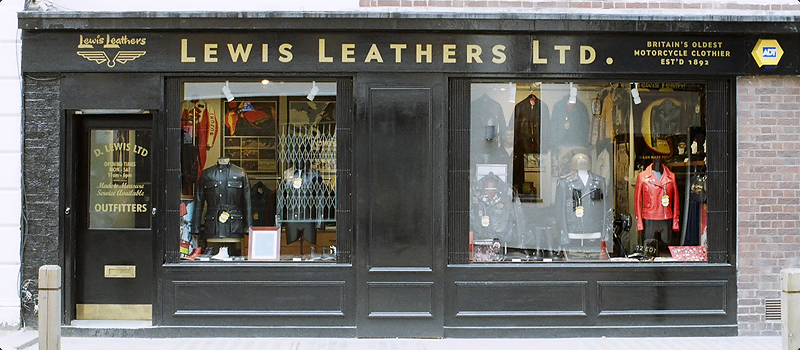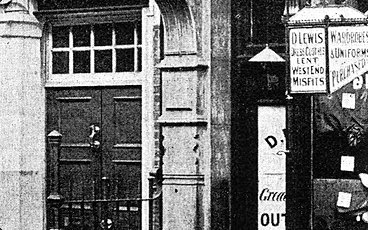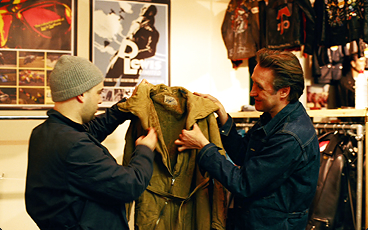History of Lewis Leathers Part1
Most important brand "Lewis Leathers" in history of British culture.
Derek Harris, the 5th generation owner, tells tradition and innovation.
10 4/14 UP
Text:Andrew Bunney Photo:Tommy Translation:Mayumi Horiguchi

- A :
- When did Lewis Leathers begin?
- D :
- From my research, the company started life as “D. Lewis” without the “Limited” and goes back to 1892, and was always based at 124 Gt. Portland St.
- A :
- What were they making in 1892?
- D :
- I’ve got a photograph from 1907 and it looks basically like rain macs or trench coats, weather wear. It’s actually a photograph from the building next door and you can see a slither of D Lewis Ltd, which I found at the Westminster Library Archives. You can see the coats in the window, suiting, more like gabardine-type(*3) coats and overcoats.
- A :
- Did these have a purpose?
- D :
-
For walking around in the street, to keep warm and dry. By 1929 it became D. Lewis Ltd, by which time they were certainly making flying gear and had been for some time. I’ve got old adverts, which say they were making old competition motorcycle racing gear from 1926.



- A :
- The flying gear was military?
- D :
-
They were supplying governments throughout the world according to the catalogues. Belgium, South America, everywhere.
A lot of private purchase, guys that had their own private aeroplanes would buy the stuff and that was open cockpit, made to the best quality that they had at the time – helmets, boots, goggles, gloves, one-piece flying suits, big flying coats. By the time WWII broke out, they were a contractor making stuff for the RAF(*4). Possibly the sheepskin flying jackets. Many of the older D Lewis customers enlisted for the RAF and continued to wear their own clothing in during their Military service.
In the early days, a lot of motoring, motorcycle and flying clothing were the same – it was all open-top cars, open-top planes and, of course, a motorcycle is open to the elements so you would want it to be as warm as possible and as dry as possible. The motorcycle coats had straps inside the skirt so you could strap it to your legs. A lot of that gear was an upgrade from horse riding gear, which is the same principle – four legs instead of two wheels but you’re still exposed.
*3:gabardine …Textile of cotton that waterproof processing is done
*4:RAF …Air force whom Britain holds. A formal name is "The Royal Air Force."
- A :
- How did the range develop?
- D :
-
They probably faltered a bit in WWII in terms of retail sales but there were government orders there. Obviously through WWII it was a bit of a tough time because you couldn’t sell to private flyers because there were no private flyers – you couldn’t have planes flying around willy-nilly in the war, so I think the motorcycle clothing was a bit more concentrated on. Little by little it became more designed for its purpose. So for motorcycling, instead of a coat you’d have a jacket and pair of trousers, or a one-piece suit for flying. They would have giant pockets for maps, or pockets in the trousers because when you’re flying you need a notepad. Cycle gear was becoming more and more specialised.
As we came out of WWII, motorcycles took off incredibly because of petrol rationing. A bike would go much further on a gallon of petrol a week than a car. So you had this huge boom of motorcycling. The catalogues reflect this where in 1952 you have a lot of motorbikes, with a bit of flying gear in, whereas you get to 56 and it’s almost all-motorcycling gear. 58 there is no flying gear at all although you could still buy it in the shop. Flying had moved on too – there were enclosed cockpits on private planes by then, so motorcycling was the place to be for this kind of stuff.
- Come 55 - 56, with the advent of the Wild One movie and teenagers having for the first time a bit of cash in their pockets after the war they wanted their own look – short waisted leather jackets – and Lewis Leathers were the first British company to cater to these riders. Maybe one of the first companies to exploit teenagers or ‘teenage’ itself.
- A :
- A lot of the influences for the teenagers were American. Is there a lot of difference between what Lewis was producing and an American company like Schott or Buco(*5) for example?
- D :
-
Although they wanted the American look, there is quite a lot of difference…
America hadn’t lost a lot of money after WWII: they had a lot of incredible products that defied description in this country. Fine quality clothing, Levi’s, colour TV’s… and a lot of English kids were living in foggy grey London, amongst bombsites with nowhere to go. But then you look at America and there’s Coney Island, Rock ‘n’ Roll, and this is what they thought was cool.
*5:Buco …Legendary riders brand


